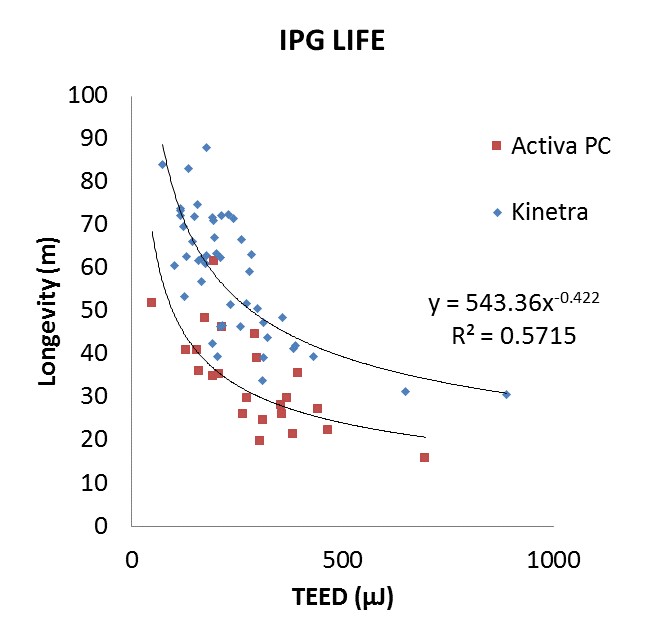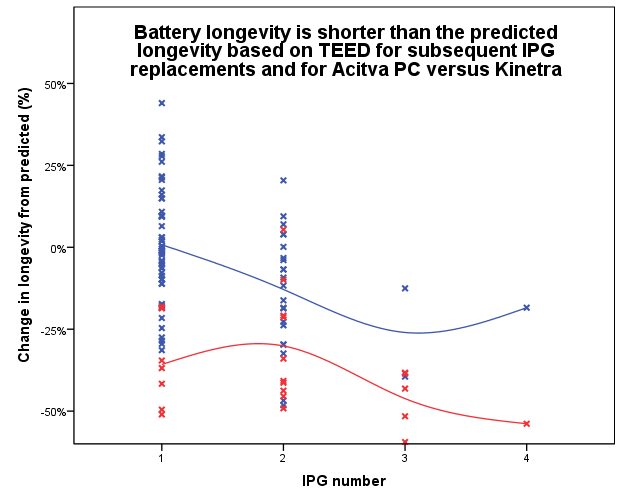Session Information
Date: Monday, June 5, 2017
Session Title: Surgical Therapy: Parkinson’s Disease
Session Time: 1:45pm-3:15pm
Location: Exhibit Hall C
Objective: To determine the effects of stimulation parameters, IPG model and the number of previous IPG replacements on IPG battery longevity.
Background: For some patients rechargeable batteries is not an option. It is known that total electrical energy delivered (TEED) and stimulation modi can affect battery longevity. There have also been reports that the certain targets and certain conditions may also result in higher battery drain (e.g., pallidal DBS for dystonia) but this may be secondary to higher stimulation parameters.
We have observed a decreasing battery longevity with each successive IPG replacement.
Methods: Sixty-two PD patients (37 male), treated with bilateral subthalamic DBS, Kinetra or Activa PC, 59.1 ± 9.8 years-old, with at least one IPG battery replacement, in total 80 Kinetra and 23 Activa IPGs, were identified from a database of patients followed up at the Movement Disorders Institute, Sheba Medical Center.
In order to take into account stimulation parameters we created a model to predict battery longevity using the trendline tool in Excel. The best goodness of fit (R2>0.57) was achieved by assuming a power relationship. We used the data from the largest subgroup (Kinetra, only the first IPG per patient). The TEED-longevity curves for these IPGs and for all Activa PCs are shown in Figure 1.
[figure1].
We used percentage change in observed battery longevity versus that predicted by the TEED as the outcome measure.’
Results: The mean and standard deviations of the age of the age of the first operation, TEED and battery longevity and percentage change from predicted battery longevity are presented in Table 1.
[table1].
Battery longevity decreased from 57.6 months to 30.7 months from the 1st Kinetra to the 3rd Kinetra and the percentage change from the predicted battery longevity drooped from 0.8 to -26 and from -36 to -46 in Kinetras and Activas respectively from the 1st to the 3rd replacement. The main effect for IPG model was p<10-6 and for IPG number was p<10-3.
Conclusions: We show here that independently of stimulation parameters there is an effect of both IPG number and IPG model. There are potential clinical implications to these findings which may influence the choice of IPG as well as stimulation parameters.
To cite this abstract in AMA style:
S. Israeli-Korn, T. Fay-Karmon, S. Tessler, G. Yahalom, S. Benizri, H. Strauss, Z. Zibly, R. Spiegelmann, S. Hassin. The battery longevity of implantable pulse generators (IPG) in Parkinson’s disease (PD) is affected by IPG model, number of previous IPG replacements and stimulation energy delivered. [abstract]. Mov Disord. 2017; 32 (suppl 2). https://www.mdsabstracts.org/abstract/the-battery-longevity-of-implantable-pulse-generators-ipg-in-parkinsons-disease-pd-is-affected-by-ipg-model-number-of-previous-ipg-replacements-and-stimulation-energy-delivered/. Accessed December 5, 2025.« Back to 2017 International Congress
MDS Abstracts - https://www.mdsabstracts.org/abstract/the-battery-longevity-of-implantable-pulse-generators-ipg-in-parkinsons-disease-pd-is-affected-by-ipg-model-number-of-previous-ipg-replacements-and-stimulation-energy-delivered/



